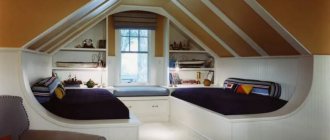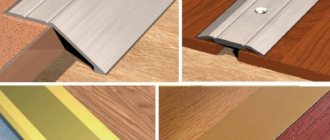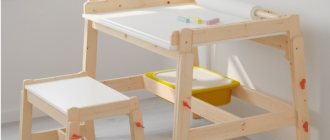A wardrobe is an important room in a house or apartment. You can put winter, spring, autumn outerwear and shoes in it. The presence of this corner will allow you to rationally calculate the entire space of your home and remove bulky items that often take up most of the space in closets. But first you need to correctly calculate the size of the dressing room and it is advisable to do this at the design stage, but this is not always possible. If this room is not provided, then you can arrange it yourself.
How to calculate the size
It is important to calculate the size of the dressing room at the design stage itself. In the future, this will make it easier to arrange this room and help you do it right.
To correctly calculate the size of the dressing room, it is worth dividing all the work into several stages:
- the type and quantity of things to be stored is determined;
- zoning - here you need to determine the level of depth and calculate the size of the width.
Determining the type and quantity of things to store
Many people often have a constant accumulation of things in their apartment, which can occupy most of the premises. So that they are nearby, but do not take up much space, you need to put them in the dressing room. However, a dressing room is not always provided for standard apartments, so you often have to arrange it yourself. You definitely need to evaluate the number and type of things to store.
What things should be stored in this room:
- outerwear - coats, jackets, down jackets, windbreakers. It is imperative to evaluate the size, volume and heaviness of this type of clothing;
- You can put warm sweaters, cardigans, and sweaters in your wardrobe. Especially in the warm season;
- various pants, trousers, dresses, skirts. Typically these items should be hung on hangers;
- The dressing room must have space for storing various shoes of winter, spring, autumn and summer types.
It is worth assessing the total number of things that you plan to put in the dressing room. The size of the dressing room, as well as the number of lockers and drawers for storing clothes, will depend on this condition.
Zoning
The ergonomics of the dressing room should provide a convenient location of all areas in which you can fit a lot of things. But at the same time, this room should not be cluttered.
All things are different, they need to be put away on the upper shelves, hung on hangers, and placed on the lower shelves. For this reason, it is important that the dressing room is divided into zones. It is usually divided into several zones:
- upper zone - this segment is located at a level of 200-250 cm from the floor. These are mezzanines that are designed for folding out-of-season or rarely used clothes. The height of this area should be about 50 cm;
- middle zone - this part is located at a height of 60 to 170 cm from the floor surface. Usually this area has to be used frequently. Here it is recommended to hang things on hangers and rails; you can also install open shelves for sweaters. Bed linen, towels, and accessories should be stored behind closed fronts and in chests of drawers;
- the lower zone is the area that is 70 cm from the floor surface. This area is the most ideal place to store shoes, heavy items, and various bags. This area is not used very often.
Upper
Average
Lower
Depth detection
Before you begin making calculations, it is worth finding out the specific configuration of the dressing room. The type of configuration should be determined depending on the filling of the internal space of the sections. If a rod with a longitudinal structure parallel to the wall is placed in this room, then the depth of the dressing room should be at least 65 cm.
If hangers are placed around the perimeter of the dressing room, then for a suitable arrangement of shoes, you will need to install a special shoe cabinet below the hangers. The depth of the shoe cabinet should be at least 35 cm.
The optimal size of dressing rooms, namely their depths, must be calculated according to the following scheme:
- it is necessary to add the depth of the shelves, the width of the door and the passage;
- if the room involves the placement of drawers, then the depth is also calculated;
- if the wardrobe cabinets have doors with a sliding structure, then the width of this room will be equal to the width of the cabinet and the passage part;
- The most ideal size for the depth of a dressing room is considered to be 100 cm.
When calculating, it is important to take into account the person’s height
Wardrobe filling option
Width calculation
It is advisable to first make a drawing on which you can mark the parameters of this corner. This will make the task of properly arranging the room much easier.
When installing furniture along the wall surface, the width of the dressing room should be calculated according to the following diagram:
- The width of the cabinet door and the size of the passage are added to the depth of the cabinet. A room with a width of 1 m would be a suitable option;
- if the wardrobe has cabinets without doors, but with sliding drawers, then the width size is calculated as follows: the size of the passage area is added to the two depths of the cabinet. Typically the width is also 1 meter;
- if the doors have a sliding system, and instead of drawers there are shelves, then the width should be calculated as follows - the size of the passage area is added to the size of the depth of the cabinet.
If the furniture is installed along the opposite wall, then the width size is calculated as follows:
- you need to add two cabinet depths, as well as two sizes of the width of the open doors of the cabinets and the width of the passage part of at least 30 cm. If all the calculations are performed correctly, the doors will open freely and people will be able to calmly dress indoors;
- if the cabinet does not have doors, then the size of the passage part is added to two depths. The width in calculations should be 1 meter;
- if the dressing room has a cabinet without doors, but with drawers, then you need to add 4 cabinet depths.
When calculating the width, it is worth taking into account standard clothing sizes
Zoning
The correct location of all areas where things are located, easy access to the necessary wardrobe items and the absence of clutter will make the dressing room ergonomic and comfortable. To do this, zoning of the premises is carried out.
The simplest way of zoning: vertically separating three zones:
- mezzanine or upper zone - located at a height of 180 - 250 cm from the floor. This part is perfect for storing light, but bulky and rarely used items: out-of-season clothing and accessories, blankets, rugs, sweaters;
- the middle part is at a height of 60-170 cm from the floor. This area has to be used often, so you should think carefully about its arrangement. Here you can place things on hangers, as well as open shelves with clothes that don’t wrinkle too much (jeans, T-shirts). But it is better to place bed linen and towels in closed sections or trunks to protect them from dust;
- in the lower zone - below 60 cm from the floor, you should place shoes, bags, suitcases, as well as heavy things and household appliances.
If you have limited space for a dressing room, you can move the border of the upper and lower zones depending on what type of things you will store more. To place more hanger rods at the top, you can use a pantograph. To place it in the lower part, use trousers or the second row of crossbars.
Storage Dimensions
An important criterion when arranging a dressing room is the correct calculation of places for storing things. It is important that the systems do not occupy a large area, but at the same time accommodate a lot of clothes. Every thing should be in its place and at hand.
For clothes on hangers
Typically, most of the dressing room is occupied by the area with hangers. This area is intended for hanging coats, jackets, down jackets, and fur coats. Also in this area should be placed hangers with trousers, dresses, skirts and other items that are intended to be hung on hangers.
In order to correctly calculate the size of the area for hangers, you need to pay attention to the following important criteria:
- the dimensions of the hangers, which are intended for an adult, are approximately 45 cm;
- for hanging a shirt, the distance from the floor to the bar should be 100 cm, for a suit - 140 cm, for a long dress - 180 cm;
- each hanger with clothes will require at least 7 cm;
- To save space, you can use elevator-type mechanisms or lifting rods.
Correct placement of roof rails and shelves is the key to convenient use
Shelves
Storage systems must have shelves. On the shelves you can store various bed linens, blankets, rugs and other bulky items. Shelves can be stationary or retractable.
If the shelves are deep, then they should move forward. This requirement allows you to access things that are stacked closer to the wall. To prevent the contents from falling out, it is desirable that they have a limit.
A few recommendations for a dressing room with shelf sizes:
- for beds, towels and other bulky items it is worth using shelves with the maximum width;
- for small items and accessories - hats, bags, small shelves with a height of 15-17 cm and a depth of 25 cm are suitable;
- When choosing shelves, you should consider how much space the folded items will take up. Typically this figure is 25-30 cm.
Calculation of the size of shelves for shirts
An example of placing shelves in a dressing room Dimensions of shelves
For shoes
You can store different types of shoes in your wardrobe - winter, summer, autumn, spring. The shoe storage area should be arranged according to the following characteristic qualities of shoes:
- the average length of men's boots size 43 is 28-30 cm;
- The width of men's shoes is 25 cm;
- the standard height of women's and men's boots is not higher than 15 cm, high-top winter boots can be 25 cm in height;
- The height size of women's boots can be from 45 to 60 cm;
- shoes with heels in depth can take from 29 to 34 cm, width from 19 to 26 cm, height from 16 to 21 cm;
- shoes with flat soles can be from 29 to 34 cm in depth, width from 19 to 26 cm, height from 16 to 21 cm;
- high shoes - depth from 31 to 36 cm, width from 21 cm to 31 cm, height from 26 to 36 cm.
You can store shoes in boxes, on open shelves, on special stands, or in a suspended state. Shoe racks with a retractable design are considered a good option. They are quite roomy and do not take up much space.
What to consider when calculating the size of a shoe rack
Shoe section option
Drawers
Drawers with a sliding mechanism are considered convenient and spacious. To make them slide out easily, I install special mechanisms on these products. Due to this, you can easily push the structure into place, without applying much effort.
The inside of the boxes can be divided by partitions into several segments. This allows you to put a certain type of clothing and things in each compartment, preventing mixing.
Drawers are produced in different sizes. Large boxes are convenient for storing linen and bedding. In smaller drawers you can store small things and various small accessories.
Honeycomb baskets
Cellular baskets are considered convenient places for storing various things - outerwear, bed linen, blankets, pillows, and so on. The baskets are attached to the wall using special guides and brackets. They occupy a small area, have good capacity and versatility.
Due to the fact that these products have a lattice design, the laundry stored in them is constantly ventilated and is not affected by mold. In addition to baskets, honeycomb shelves, rods, trouser racks, and shoe shelves are produced.
Dimensions of honeycomb baskets:
- width varies from 25 to 90 cm;
- depth from 8 to 28 cm;
- the size of each cell can be from 2 mm to 2 cm.
Special accessories
In addition to shelves, drawers, hangers, baskets and other important components for storing things, it is necessary to provide important accessories for storing small items. Accessories include the following:
- devices for hanging trousers, trousers, skirts;
- special holders for ties and belts;
- hooks for umbrellas, bags;
- stands for hats, caps, various headdresses.
Important Planning Tips
A dressing room with an area of no more than 3 square meters should be ergonomic and spacious. But in order to make it truly convenient and functional, it is worth considering several important planning recommendations:
- It is advisable to separate a compartment for each member, this will help avoid confusion;
- It is worth allocating storage space for things that are rarely used;
- You need to plan the room so that there is some free space left in it. What it will be like is up to everyone to decide for themselves;
- everything needs to be thought through carefully. First of all, you should decide where to place the long hangers; all other elements are placed around them. Hats should be placed on the top, and shoes on the bottom shelves;
- The width of the passage should be at least 60 cm. This is how a proper dressing room is planned.
Arranging a dressing room is a rather complex process. It is important to calculate everything at the planning stage itself, so that in the future there will be no problems with the arrangement of this room. If everything is done correctly, you can end up with a comfortable small wardrobe with good capacity.
Determining the depth of the dressing room sections
If the space for arranging a dressing room is not limited, choose the optimal depth option - 60 cm. If you are planning a dressing room of very small sizes, then the depth of the drawers should be calculated according to the following diagram:
- The depth of the retractable structure should be added to the depth of the shelves and additional space should be provided for free passage. For example: the entire width of the dressing room is 120 cm: 40 cm for the depth of the cabinets, 40 cm for retractable structures and about the same for the passage. The minimum width for a dressing room is 1 meter.
- if cabinets are installed on two opposite sides, then the minimum width is calculated as two cabinet depths on one side and two cabinet depths on the other side, plus a passage space of at least 30 cm.











